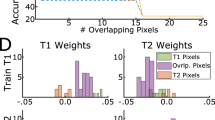Abstract
We review the performance of Hebbian unlearning in a neural network with parallel dynamics and stationary patterns. One of the main problems of Hebbian learning, and any local coding procedure, is that it cannot store extensively many patterns with different activities — the synaptic coding problem. The reason behind it is that undesirable correlations are introduced during learning. Hebbian unlearning is an unsupervised procedure whose main function is to remove these correlations. Its characteristic features are: (i) A solution of the synaptic coding problem which is so good that the storage capacity is near to or even saturating the theoretical upper bound, (ii) The existence of an optimal and a critical number of dreams at and above which, respectively, storage and retrieval are optimal (D opt ) or break down completely (D c ) so that all information is lost, (iii) The existence of a critical resemblance, or overlap, mc so that for an initial overlap to, greater than m c the network always converges to a pattern whereas for mi less than mc it relaxes to a state with blinking neurons, thus signaling that it had not seen this state before, (iv) For neurons with self-interaction the convergence time, which is to be interpreted as the duration of a dream, diverges at D opt < D c so that it is hard to do too much unlearning. The consequences for ordinary REM sleep are discussed.
Access this chapter
Tax calculation will be finalised at checkout
Purchases are for personal use only
Preview
Unable to display preview. Download preview PDF.
Similar content being viewed by others
References
Winson, J. The meaning of dreams. Sci. Amer. 1990; 263: 42–48.
Freud, S. The interpretation of dreams. Penguin books, London and New York, 1976. Originally published 1900.
Smith, C. and Kelly, G. Paradoxical sleep deprivation applied two days after end of training retards learning. Psych, and Behav. 1988; 43: 213–216.
Pavlides, C. and Winson, J. Influences of hippocampal place cell firing in the awake state on the activity of these cells during subsequent sleep episodes. J. Neurosc. 1989; 9: 2907–2918.
Hennevin, E., Hars, B., and Bloch, V. The improvement of learning by mesencephalic reticular stimulation during postlearning paradoxical sleep. Behav. Neural Biol. 1989; 51: 291–306.
Hobson, J.A. and McCarley, R.W. The brain as a dream state generator. An activation-synthesis hypothesis of the dream process. Am. J. Psychiat. 1977; 134: 1335–1348.
Crick, F. and Mitchison, G. The function of dream sleep. Nature 1983; 304: 111–114.
Hopfield, J.J., Feinstein, D.I., and Palmer, R.G. “Unlearning” has a stabilizing effect in collective memories. Nature 1983; 304: 158–159.
Crick, F. and Mitchison, G. REM sleep and neural nets. J. Mind and Behavior 1986; 7: 229–250.
Clark, J.W., Winston, J.V., and Rafelski, J. Self-organization in neural networks. Phys. Lett. A 1984; 102: 207–211.
Clark, J.W., Rafelski, J., and Winston, J.V. Brain without mind: Computer simulation of neural networks with modifiable neuronal interactions. Phys. Rep. 1985; 123: 216–273.
van Hemmen, J.L., Gerstner, W., Herz, A.V.M., Kühn, R., and Vaas, M. Encoding and decoding of patterns which are correlated in space and time. In: Dorffner, G. (ed.) Konnektionismus in Artificial Intelligence und Kognitions-forschung. Springer, Berlin and Heidelberg, 1990, pp. 153–162.
Herz, A.V.M., Sulzer, B., Kühn, R., and van Hemmen, J.L. The Hebb rule: Storing static and dynamic objects in an associative neural network. Europhys. Lett. 1988; 7: 663–669.
Herz, A.V.M., Sulzer, B., Kühn, R., and van Hemmen, J.L. Hebbian learning reconsidered: Representation of static and dynamic objects in associative neural nets. Biol. Cybern. 1989; 60: 457–567.
Hopfield, J.J. Neural networks and physical systems with emergent collective computational abilities. Proc. Natl. Acad. Sci. USA 1982; 79: 2554–2558.
van Hemmen, J.L., Ioffe, L.B., Kühn, R., and Vaas, M. Increasing the efficiency of a neural network through unlearning. Physica A 1990; 163: 386–392.
van Hemmen, J.L. Hebbian learning and unlearning. In: Theumann, W.K., and Köberle, R. (eds.) Neural networks and spin glasses. World Scientific, Singapore, 1990, pp. 91–114.
Herz, A.V.M., Li, Z., and van Hemmen, J.L. Statistical mechanics of temporal association in neural networks with transmission delays. Phys. Rev. Lett. 1991; 66: 1370–1373.
Gardner, E. The space of interactions in neural network models. J. Phys. A: Math. Gen. 1988; 21: 257–270.
Author information
Authors and Affiliations
Editor information
Editors and Affiliations
Rights and permissions
Copyright information
© 1992 Springer-Verlag London Limited
About this paper
Cite this paper
van Hemmen, J.L., Klemmer, N. (1992). Unlearning and Its Relevance to REM Sleep: Decorrelating Correlated Data. In: Taylor, J.G., Caianiello, E.R., Cotterill, R.M.J., Clark, J.W. (eds) Neural Network Dynamics. Perspectives in Neural Computing. Springer, London. https://doi.org/10.1007/978-1-4471-2001-8_3
Download citation
DOI: https://doi.org/10.1007/978-1-4471-2001-8_3
Publisher Name: Springer, London
Print ISBN: 978-3-540-19771-3
Online ISBN: 978-1-4471-2001-8
eBook Packages: Springer Book Archive




